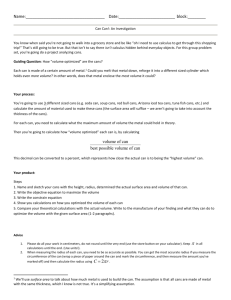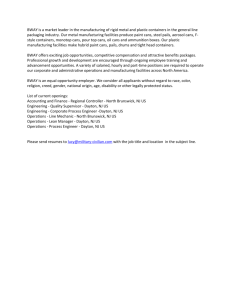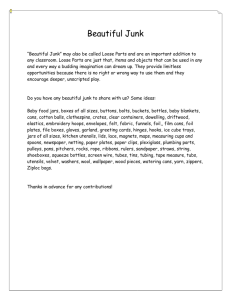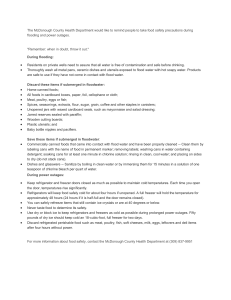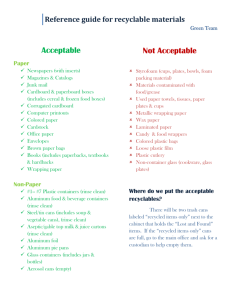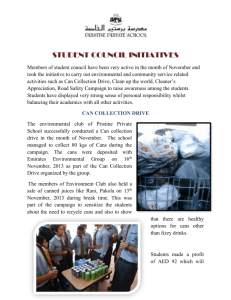Name: Date: Band:______ Calculus | Packer Collegiate InstituteCan
advertisement
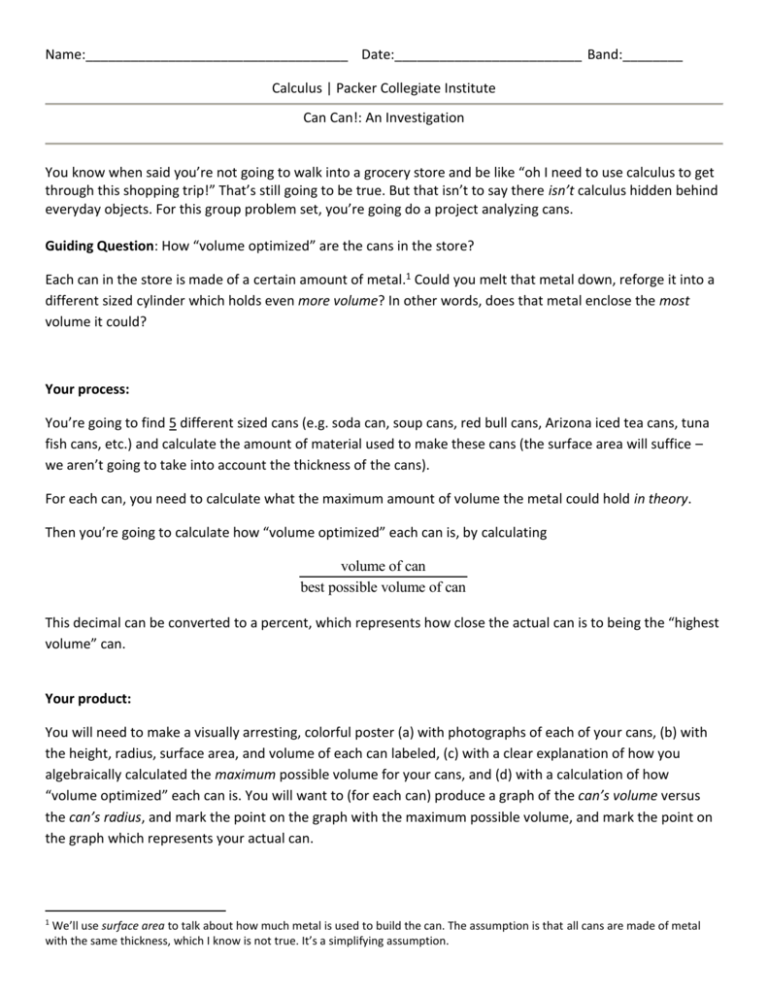
Name:___________________________________ Date:_________________________ Band:________ Calculus | Packer Collegiate Institute Can Can!: An Investigation You know when said you’re not going to walk into a grocery store and be like “oh I need to use calculus to get through this shopping trip!” That’s still going to be true. But that isn’t to say there isn’t calculus hidden behind everyday objects. For this group problem set, you’re going do a project analyzing cans. Guiding Question: How “volume optimized” are the cans in the store? Each can in the store is made of a certain amount of metal.1 Could you melt that metal down, reforge it into a different sized cylinder which holds even more volume? In other words, does that metal enclose the most volume it could? Your process: You’re going to find 5 different sized cans (e.g. soda can, soup cans, red bull cans, Arizona iced tea cans, tuna fish cans, etc.) and calculate the amount of material used to make these cans (the surface area will suffice – we aren’t going to take into account the thickness of the cans). For each can, you need to calculate what the maximum amount of volume the metal could hold in theory. Then you’re going to calculate how “volume optimized” each can is, by calculating volume of can best possible volume of can This decimal can be converted to a percent, which represents how close the actual can is to being the “highest volume” can. Your product: You will need to make a visually arresting, colorful poster (a) with photographs of each of your cans, (b) with the height, radius, surface area, and volume of each can labeled, (c) with a clear explanation of how you algebraically calculated the maximum possible volume for your cans, and (d) with a calculation of how “volume optimized” each can is. You will want to (for each can) produce a graph of the can’s volume versus the can’s radius, and mark the point on the graph with the maximum possible volume, and mark the point on the graph which represents your actual can. 1 We’ll use surface area to talk about how much metal is used to build the can. The assumption is that all cans are made of metal with the same thickness, which I know is not true. It’s a simplifying assumption. Advice 1. Please do all your work in centimeters, round to the nearest tenth, and keep in all calculations until the end. (Use units!) 2. When measuring the radius of each can, you need to be as accurate as possible. You can get the most accurate radius if you measure the circumference of the can (wrap a piece of paper around the can and mark the circumference, and then measure the amount you’ve marked off) and then calculate the radius using C 2 r . 3. When graphing, you should use www.desmos.com (an online graphing calculator). Type the equation in on the left hand window, and click on settings to set the x-min/x-max, y-min/y-max. To save the graph, click on save/share (you may need to create an account to do this). 4. You may not want to write out the calculation for each can on your poster. Instead, after working out the problem for a couple cans, can you come up with a way to show how you’d get the answer for a can with any surface area? Putting that on the poster, with some explanation of what you’re doing in each stop, will be useful. The due date for this project is: __________________________________________ Checklist/Rubric: ____ a clever title (more cleverer than the title of this worksheet) ____ beautiful photographs of 5 cans ____ the height, radius, surface area, and volume of each can labeled (in cms, to the nearest tenth) ____ a derivation for how to calculate the maximum possible volume for each can ____ the derivation is neatly written ____ each step in the derivation is clearly explained ____ calculus concepts are explained (e.g. why do we set the derivative equal to 0?) ____ algebraic steps are explained (why are we allowed to do tricky algebraic moves?) ____ a calculation of how “volume optimized” each can is (the percent) ____ a graph with the Volume vs. Radius graphed for each can ____ the graph has a proper Xmin, Xmax, Ymin, Ymax ____ the graph has labeled x- and y-axes (with what each axes represents) ____ the graph has a clearly marked point which represents the most “volume optimized” can ____ the graph has a clearly marked point which represents the actual can ____ the poster is neatly put together, organized in a logical, coherent way ____ the poster has no calculation errors ____ the poster has no algebraic/calculus errors ____ the poster uses color! ____ the poster’s text is neat ____ the poster shows an effort at creativity, and that effort has been put into each component ____ each student individually writes 2-3 paragraphs explaining what they individually contributed to the project, and how they worked with their partner(s) (with examples); each student should put this in a sealed envelope.
